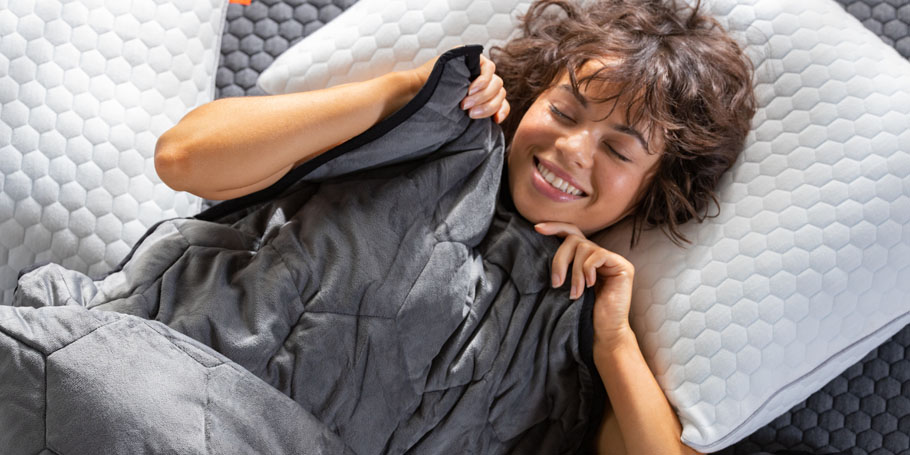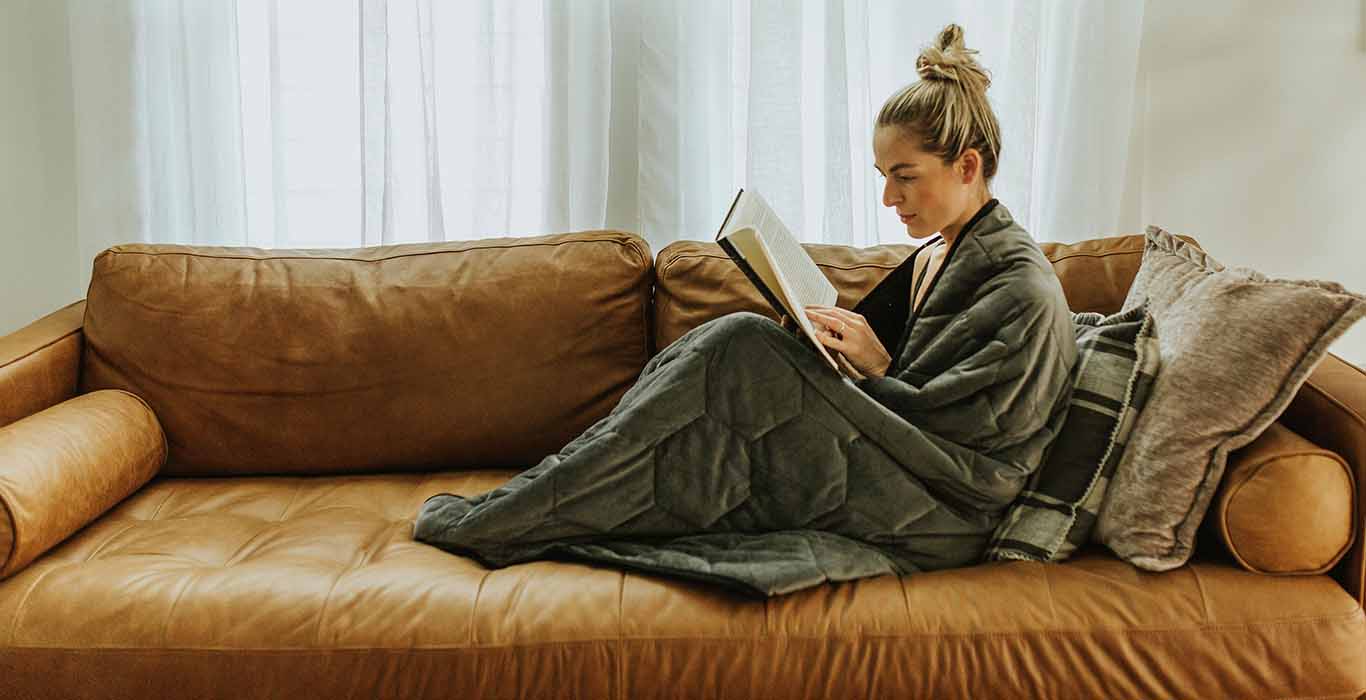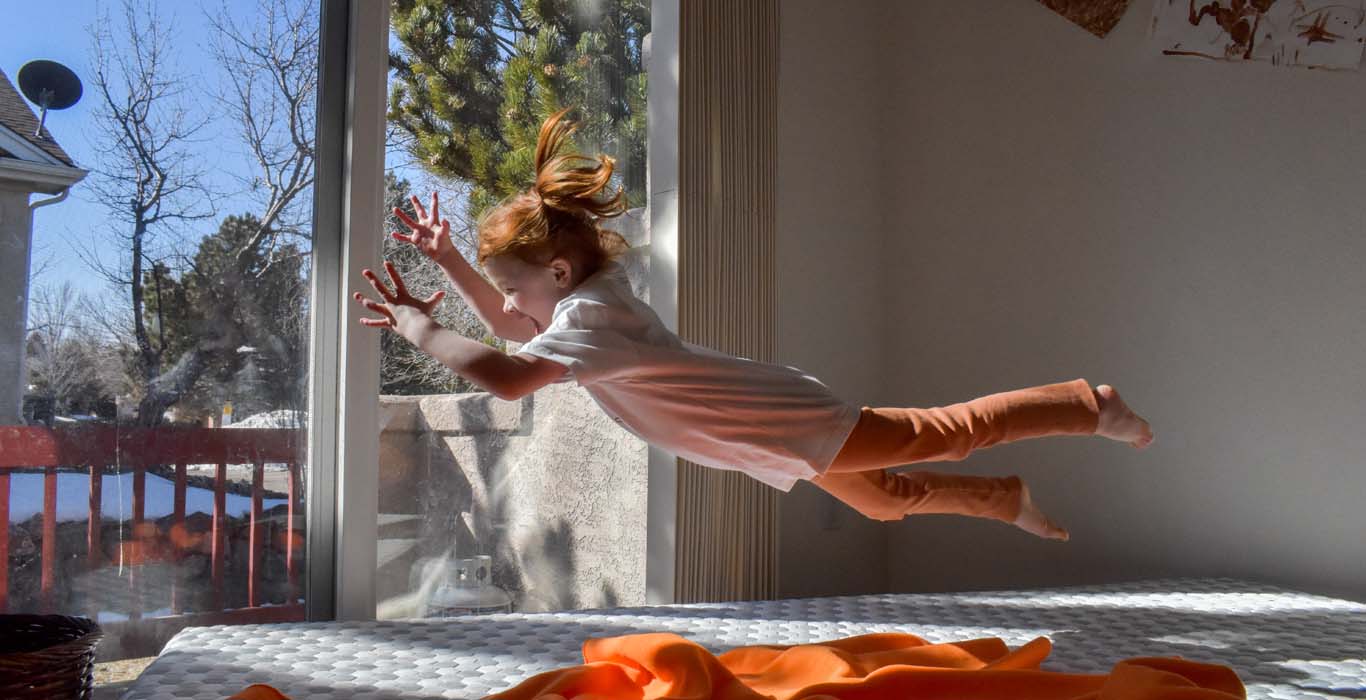With that said, many have found comfort and respite from restless leg syndrome, anxiety, and other disorders by using a weighted blanket. Below, we’ll dive into what restless leg syndrome is, using weighted blankets for restless leg syndrome, along with the benefits of weighted blankets, how they work, and additional health conditions they may ameliorate.
- What Is Restless Leg Syndrome?
- How Do Weighted Blankets Work?
- What Is Deep Touch Pressure Therapy?
- Do Weighted Blankets Work for Restless Leg Syndrome?
- What Are Other Benefits of Weighted Blankets?
- The Layla Sleep Weighted Blanket: Take a Load Off
What Is Restless Leg Syndrome?
Restless leg syndrome (RLS) is a disorder that causes people to have a strong urge to move their legs when resting. Restless leg syndrome typically flares up at night during sleep but can occur at any point throughout the day, such as watching TV or sitting in an office chair. Common feelings of restless leg syndrome include:
- Tingling
- Prickling
- Twitching
- Burning
- Itching
- Crawling
- Tickling
When RLS flares up, a person will get a strong urge to walk, shift, or stretch their legs. This unpleasant feeling can be difficult to live with, which is why it’s important to find solutions that can help relieve the symptoms, such as weighted blankets for restless legs, which we’ll explore further in the sections below. But before we dive into weighted blankets for restless leg syndrome, let’s take a look at possible causes of restless legs.
What Causes Restless Leg Syndrome?
Unfortunately, there still needs to be more research into the causes of restless leg syndrome. However, there are a few generalizations that can point to some of the reasons why your legs have the urge to move when you’re resting. Some potential causes of restless leg syndrome include:
- Current health conditions like diabetes or anemia
- Pregnancy
- Imbalance of dopamine in the brain
- Genetics
These are just some of the potential causes of RLS. Fortunately, this condition is non-life-threatening and can be managed with a few at-home solutions, such as weighted blankets. Now that we know more about what restless leg syndrome is, let’s explore more about weighted blankets and restless legs.
How Do Weighted Blankets Work?
Weighted blankets feature a filling that’s—you guessed it—weighted. Some are filled with poly or metal filling, but blankets like the Layla Weighted Blanket, for example, feature glass beads. The beads are tiny and sewn in between layers of the blanket. No matter the kind of fill you choose, they’re strategically lined up, so the weight is evenly distributed across your body.
Weighted blankets work in a way that is similar to an occupational therapy strategy called deep touch pressure therapy or DTP.
What Is Deep Touch Pressure Therapy?
Before you can understand why DTP works for certain people, it’s important to understand how your body works to process anxiety. The sympathetic nervous system (SNS) acts as your body’s integrated alarm bells. For example, when you miss a deadline at work or get into a fender bender during your commute, these types of situations typically set off your body’s alert system.
With that said, it’s normal to feel stressed. Stress is your body’s evolutionary response to danger—it was imperative for early humans to feel stress to react appropriately to danger. But cavemen didn’t have to handle feelings of FOMO after seeing all their friends at a party or panic after realizing they didn’t pay their taxes on time. Our stresses these days consist of more subtle and potentially more numerous sources beyond the neighborhood saber-toothed tiger.
But while stress is a natural reaction to worrying situations, it can take over and cause long-term feelings of fatigue, anxiety, and irritability. As a result, you might not sleep as well, and your digestive system might go on the fritz.
Your parasympathetic nervous system (PSNS) is the opposite of the sympathetic nervous system. You can think of your sympathetic nervous system (SNS) as the underlying cause of your fight or flight response when faced with a trying situation. Your PSNS helps to conserve your body’s energy by moving it back toward homeostasis. It’s what brings you some calm to both your body and mind after a period of stress. The physical effects of your PSNS include a slowed heart rate, relaxed muscles, and improved blood circulation.
When you put pressure on the body in the form of DTP, it can promote the activation of the parasympathetic nervous system. It may lead to an increase in endorphins in your brain, which are also the hormones released when you get that “runner’s high.” Neurotransmitters like dopamine and serotonin also get released, bringing about a sense of peace and well-being.
While it’s possible to practice DTP with just manual hand pressure, it’s a little easier to get the same effects from a weighted blanket. Plus, it’s nearly impossible to give yourself DTP, but with a weighted blanket, you can get all the same benefits.
So, what are weighted blankets used for? They can be used as a therapeutic practice for a variety of health conditions, including restless leg syndrome, which we’ll explore in-depth below.

Do Weighted Blankets Work for Restless Leg Syndrome?
People wonder, are weighted blankets good for restless leg syndrome? The short answer is yes, weighted blankets are a great tool to help reduce the symptoms of RLS to allow you to gain quality sleep. As you know, restless legs syndrome is characterized by the urge to move your legs, usually occurring in tandem with sensations like crawling, itching, cramping, burning, numbness, tingling, or pain. One way to counter the annoying sensations of RLS is by providing your brain with “counter stimulation” in the form of a weighted blanket. Weighted blankets for restless legs syndrome can help counteract and neutralize those prickly feelings in leg muscles, allowing you to sleep without frustrating interruptions from RLS.
Weighted blankets have also been proven to reduce the levels of cortisol when you sleep, which is the stress hormone that can be to blame when it comes to sleeping with restless legs. There’s also some research that anxiety and restless leg syndrome are connected to one another. So buying a weighted blanket can serve to quell those anxious thoughts in addition to any pain or tingling.
Other Solutions for Restless Leg Syndrome
In addition to using weighted blankets for restless legs syndrome, there are a few other at-home remedies that can help keep your legs relaxed and calm. Some ways you can manage your RLS include:
- Living a healthy, balanced lifestyle that includes plenty of exercise and nutritious foods
- Avoiding stimulants like caffeine that can heighten the symptoms of RLS
- Implementing relaxation techniques like deep breathing, yoga, and meditation into your routine
- Stretching to help your muscles relax
- Visiting a doctor to see if iron or magnesium supplements can help
What Are Other Benefits of Weighted Blankets?
If you’re tossing and turning due to a tingling sensation in your legs, weighted blankets for restless legs can put you at ease and help you relax. However, weighted blankets aren’t just used to quell the symptoms associated with restless legs syndrome. Explore some of the other reasons why you should get a weighted blanket below:
Weighted Blankets for Anxiety
Anxiety can be paralyzing for some adults and children. Like stress, anxiety is normal to feel once in a while, but when it’s a chronic issue, it can cause serious issues. It manifests in different ways but can cause:
- Sweating
- Weakness
- Trembling
- Rapid breathing
- Rapid heart rate
- Feelings of dread
- Restlessness
- Gastrointestinal distress
- Avoidance of triggers
- Nervousness
- Obsessive behavior
It can become more serious and escalate to a panic attack, where the body goes into its most extreme form of fight or flight mode.
There are a variety of methods to treat anxiety, like talk therapy and medication, but one of the simplest ways to do so is by using a weighted blanket. A weighted blanket alone is unlikely to solve serious anxiety issues, but for mild anxiety-inducing days, it can help your emotions and thoughts under control and your body to a place of calm. Weighted blankets have also been used to help manage the symptoms associated with PTSD.
In one study, researchers examined how effective a 30-pound weighted blanket would be for adults with anxiety. 63% of participants in the study exhibited lower physical manifestations of stress and anxiety after using the blanket. Easing anxiety is one of the main benefits of weighted blankets, a comforting physical weight that lessens some of your mental weight.
Weighted Blankets for Insomnia
A study published by UCLA Health found that the calming effects of a weighted blanket helped patients fall asleep and sleep more deeply through the night. Research has suggested that sleep and anxiety are closely intertwined. When you don’t sleep enough, it can trigger anxious feelings. And if you’re feeling anxious, you might not be able to wind down enough to actually fall asleep.
A weighted blanket is a one-two punch that reduces anxiety so you can fall asleep.
Weighted Blankets for Sensory Processing Disorder
People with sensory processing disorders receive sensory information but can’t process it in a normal way. Sight, sounds, texture, smells, taste, and movement perception can all be affected. Many children on the autism spectrum have issues with sensory stimuli and may have a sensory processing disorder. The Applied Behavioral Analysis describes the effects of deep-pressure stimulation provided by regular use of weighted blankets:
- Sense of calm
- A decrease in overall anxiety
- Increase in happiness
- Better social interactions
- Increased communicativeness
- Improved sleep
- Lower sensitivity to touch
- Decrease in self-injury
Weighted Blankets for ADHD
ADHD sufferers deal with overstimulation and distraction caused by the environment around them. Studies have shown the promise of weighted blankets to calm and organize the central nervous system. With that said, a note of caution, the use of weighted blankets for children should always be monitored. Infants and other young children should never be under a weighted blanket.
So, how heavy should a weighted blanket be? In most cases, a weighted blanket should be around 10% of the sleeper’s body weight. A woman weighing 150 pounds, for example, would want a weighted blanket around 15 pounds— sometimes a little more, sometimes a little less.
Weighted Blankets for Comfort
Babies enjoy the security and feeling of being swaddled. It’s a successful way of calming an infant that’s been practiced for thousands of years. You might be surprised that for most people, the feeling and desire to cuddle or be hugged never goes away. Of course, you might not always have a hug or cuddle from another person handy when you need it most. The comfort and soothing nature of a weighted blanket can deliver that experience and may even help you calm down from a stressful event.
The Layla Sleep Weighted Blanket: Take a Load Off
Sleep doesn’t always come easy. If you deal with anxiety or sensory issues, it’s important to discuss your medical treatment with a doctor. In tandem with your doctor’s advice, a weighted blanket from Layla Sleep may offer respite from chronic sleeplessness. Offered in 15lbs, 20lbs, and 25lbs, the Layla Weighted Blanket is the perfect addition to any bedroom. Shrug off the stress of the day and enjoy the comforting weight of a blanket designed to help you relax and fall into a deep sleep. Don’t you feel more relaxed already?
If you found our guide on weighted blankets and restless legs helpful, don’t forget to check out our other resources, such as how to wash a weighted blanket, weighted blankets and muscle recovery, and weighted blankets for couples. Layla Sleep is your go-to source for all things sleep-related.



